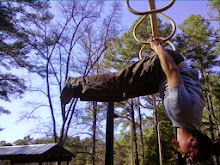



For those who have seen "Last of the Mohicans," you will recognize these pictures right away. Those of you who have not seen it, rent it, and come to Hickory Nut Gorge, Chimney Rock, and the Broad River. A breathtaking site that offers plenty of activity. Hiking, cycling, paddling, rock hopping...a little 'evolutionary' fitness along with a cold beverage at the end of the day does a body good! (No matter how you choose to consume calories...paleo, Mediterranean, North Carolinian...)
Have fun, eat well, and PLAY!
.jpg)


